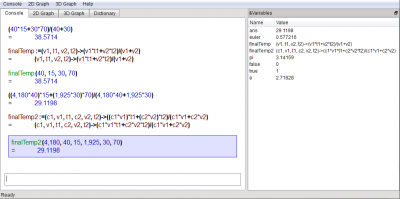KAlgebra/Homework/it: Difference between revisions
Importing a new version from external source |
Importing a new version from external source |
||
| Line 98: | Line 98: | ||
:Attuale = Voltaggio/ResistenzaTotale | :Attuale = Voltaggio/ResistenzaTotale | ||
Scriviamo una semplice funzione in '''KAlgebra''' per farlo: | |||
{{Input|1=totalresistance:=(R1,R2)->(1/R1+1/R2)^-1 | {{Input|1=totalresistance:=(R1,R2)->(1/R1+1/R2)^-1 | ||
Revision as of 18:48, 28 April 2011
Questa pagina mostra alcuni utilizzi di KAlgebra in problemi reali. \
Esempio di calcolo combinatorio
Abbiamo 6 persone che vogliono sapere come mettersi attorno a un tavolo con 6 sedie.
Sappiamo che le 6 persone possono posizionarsi attorno al tavolo in questa configurazione:
p1 p2 p3 p4 p5 p6 p1 p2 p3 p4 p6 p5 p1 p2 p3 p5 p4 p6 p1 p2 p3 p5 p6 p4
E così via.
Notiamo che l'ultimo elemento si sposta di 1, il quinto di 2, il quarto di 3, il terzo di 4, il secondo di 5 e il primo di 6. Possiamo quindi scrivere una semplice formula:
6*5*4*3*2*1
Scriviamola nella console di KAlgebra e la risposta in uscita sarà:
(((((1)*2)*3)*4)*5)*6 =720
Questo modo di organizzare le cose spostandole di alcune posizioni, in cui il numero della posizione è uguale al numero delle cose stesse, è chiamato "permutazione".
Proviamo a calcolare in KAlgebra la funzione di permutazione:
factorial(6)
e otteniamo
factorial(6) =720
Come puoi vedere è lo stesso risultato.
Esempio di calcolo della probabilità
Lanciamo un dado. Vogliamo sapere la probabilità di ottenere un certo numero.
Possiamo definire probabilità positiva il risultato dell'evento a noi favorevole e probabilità negativa il risultato sfavorevole.
Devi quindi scegliere una sola faccia del dado:
- probabilità = faccia scelta / facce totali = 1/6
Ora quindi sappiamo che quando lanciamo un dado c'è 1/6 di probabilità di ottenere la faccia che abbiamo scelto.
Possiamo impostare una semplice funzione in KAlgebra per prendere questa formula in modo facile:
probabilità:=(favorevole,totale)->favorevole/totale
Teoria dei numeri
Diciamo che vogliamo sapere la somma di tutti i numeri compresi in un dato intervallo, per esempio 1 - 100. Dobbiamo sommare tutti i numeri da 0 a 100 se non conosciamo la regola.
KAlgebra offre un'ottima semplificazione per questa operazione. Scriviamo nella console:
sum(x: x=1..100)
e otteniamo il risultato:
sum(x: x=1..100) = 5050
La sintassi indica questo:
- 1. Limite x come variabile
- 2. Prendere il primo valore di x
- 3. Prendere il secondo valore di x e aggiungere il precedente
- 4. Prendere il terzo valore di x e aggiungere il precedente
- ...
- N. Prendere l'ultimo valore di x e aggiungere l'ultimo.
Elettronica
Esempio 1
Prendiamo un semplice circuito con due ingressi e un'uscita. Per risolverlo in KAlgebra scriveremo:
and(variabile1, variabile2)
da cui otterremo come risultato il valore di ingresso.
Esempio 2
Abbiamo un semplice circuito: una batteria da 3V e due resistenze da 3kOhm (R1 e R2) messe in parallelo. Vogliamo conoscere la corrente che passa nel circuito.
Dobbiamo prima calcolare il valore della resistenza elettrica espressa secondo la legge:
- ResistenzaTotale = (1/R1 + 1/R2)^-1
- Attuale = Voltaggio/ResistenzaTotale
Scriviamo una semplice funzione in KAlgebra per farlo:
totalresistance:=(R1,R2)->(1/R1+1/R2)^-1
current:=(voltage,totalresistance)->voltage/totalresistance
Let's see what we get:
current(3, totalresistance(3000, 3000))
current(3, totalresistance(3 000, 3 000)) = 0,002
Fluid
Example Problem with Same Material, but Different Volumes and Temperatures
Now, what if we need to know the final temperature when we mix 40L of 15°C water with 30L of 70°C water?
Using conservation of energy, we know that the initial and final thermal energies are the same, so the final energy is equal to the energy of the first fluid plus the energy of the second fluid(using U for internal energy):
- U(final) = U1 + U2
Internal energy is equal to the volumetric heat capacity times volume times temperature:
- U = C*V*T
So C(final)*V(final)*T(final) = C1*V1*T1 + C2*V2*T2
And since the heat capacities are all the same and cancel out, and the final volume is the sum of the two initial volumes:
- (V1+V2)*T(final) = V1*T1 + V2*T2
- or
- T(final) = (V1*T1 + V2*T2)/(V1+V2)
We can then either use this directly in KAlgebra:
(40*15 + 30*70)/(40 + 30)
(40*15+30*70)/(40+30) =38.5714
and get the final temperature, or put in a function if we need to repeat the computation:
finalTemp:=(v1,t1,v2,t2)->(v1*t1 + v2*t2)/(v1+v2)
Which we can then use like this:
finalTemp(40,15,30,70)
finalTemp(40, 15, 30, 70) =38.5714
Example Problem with Different Fluids
Now, suppose the two fluids have different volumetric heat capacities, such as 4180 J/(L*K) for the first liquid (water), and 1925 J/(L*K) for the second liquid (ethanol).
We will need to refer back to the equation:
- C(final)*V(final)*T(final) = C1*V1*T1 + C2*V2*T2
The resultant heat capacity will be the average of the capacities of the first and second fluids, weighted by volume(since it is a volumetric heat capacity rather than mass- or molar-specific):
- C(final) = (C1*V1 + C2*V2)/V(final)
And plugging this into the previous equation, we get:
- (C1*V1 + C2*V2)*T(final) = C1*V1*T1 + C2*V2*T2
- or
- T(final) = (C1*V1*T1 + C2*V2*T2)/(C1*V1 + C2*V2)
And either use this formula directly:
(4180*40*15 + 1925*30*70)/(4180*40+1925*30)
((4,180*40)*15+(1,925*30)*70)/(4,180*40+1,925*30) =29.1198
Or write a function if we want to repeat the calculation:
finalTemp2:=(c1,v1,t1,c2,v2,t2)->(c1*v1*t1 + c2*v2*t2)/(c1*v1+c2*v2)
Which we can then use like this:
finalTemp2(4180,40,15,1925,30,70)
finalTemp2(4,180, 40, 15, 1,925, 30, 70) =29.1198
Screenshot of KAlgebra after running these computations:

